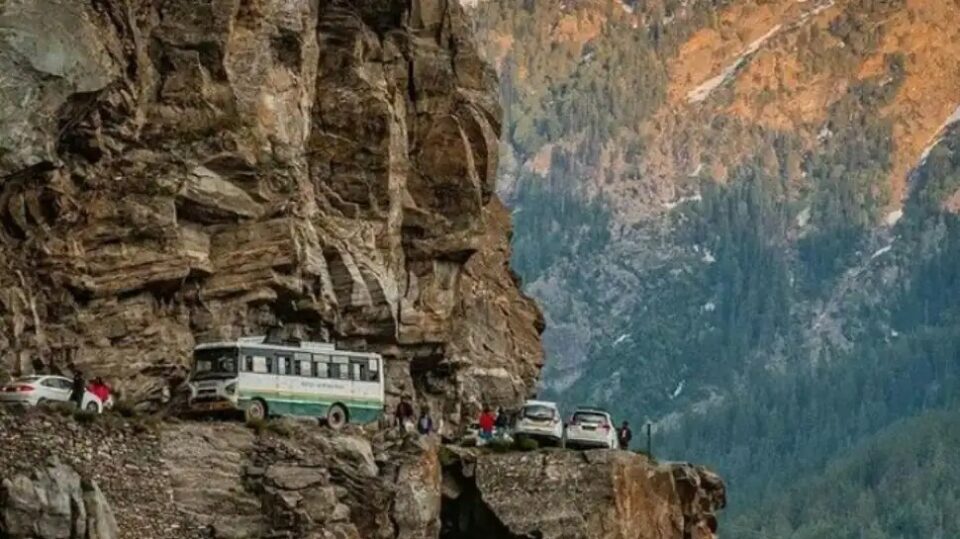India is known for its rich culture, majestic mountains, and vibrant cities—but some of its roads tell a different story. Winding through treacherous cliffs, narrow passes, and unpredictable weather, these routes are a driver’s ultimate test of skill and courage. While they offer breathtaking views and unforgettable experiences, they also demand intense focus and respect for nature’s unpredictability. Whether you’re a road trip enthusiast or just curious about the most dangerous drives in India, here’s a list of the 10 scariest roads in India that will send shivers down your spine.
Scariest Roads In India
Explore the top 10 scariest roads in India that will give even the most seasoned drivers a run for their money. Buckle up for a thrilling adventure like no other!
Zoji La Pass – Jammu & Kashmir
Elevation: 11,575 feet
Location: Connects Srinagar to Leh
Zoji La is one of the most infamous mountain passes in India. With its narrow lanes, steep cliffs, and snow-covered roads for much of the year, this route is a nerve-wracking experience even for expert drivers. Landslides and zero visibility during snowfall add to its deadly reputation.
Tip: Avoid self-driving unless you’re extremely experienced with mountain roads.
Khardung La Pass – Ladakh
Elevation: 17,582 feet
Location: Near Leh, Ladakh
Once considered the highest motorable road in the world, Khardung La is not just high—it’s dangerously high. The oxygen levels are low, and the terrain is rough. Add to that narrow icy roads and fast-changing weather, and you’ve got a real challenge for any driver.
Prolonged altitude exposure can cause AMS (acute mountain sickness). Travel with caution.
Killar-Kishtwar Road – Himachal Pradesh
Length: Approx. 114 km
Location: Connects Killar to Kishtwar
Killar-Kishtwar Road Often dubbed as the “most dangerous road in the world,” this terrifying cliff-hugging road in Pangi Valley has no guardrails and a sheer drop into the Chenab River. The road barely fits one vehicle and is carved into vertical rock faces. Slippery in monsoons and terrifying in winters, it’s not for the faint-hearted.
Only locals and extremely skilled drivers dare to venture here regularly.
Leh-Manali Highway – Himachal Pradesh to Ladakh
Length: 428 km
Highlights: Rohtang Pass, Baralacha La, Tanglang La
Leh-Manali Highway Though immensely scenic, the Leh-Manali Highway is known for its unpredictable weather, sudden landslides, and extremely high-altitude passes. It remains snow-covered for months and often lacks mobile networks or medical help nearby.
Tip: Keep fuel, food, and oxygen cylinders handy.
Neral-Matheran Road – Maharashtra
Distance: 8 km of steep incline
Famous For: Sharp hairpin bends
Neral-Matheran Road may look short on the map, but it’s one of the steepest and most dangerous hill drives in Maharashtra. Add fog, limited visibility, and monkeys darting across the road, and the risk level increases. The road is closed to private vehicles close to the hill station, and rightfully so.
Chang La Pass – Ladakh
Elevation: 17,586 feet
Conditions: Steep, icy, and oxygen-deprived
Often overshadowed by Khardung La, Chang La is no less daunting. Slippery roads and freezing temperatures year-round make it one of the scariest roads in India. It’s also known for mechanical breakdowns due to the thin air and harsh conditions.
Always check weather reports before attempting this route.
NH-22 (Old Hindustan–Tibet Road) – Himachal Pradesh
Stretch: Shimla to Khab
Risk Factor: Landslides and narrow tunnels
This route passes through some of the most unpredictable terrain in the Himalayas. Known for its dangerous overhangs and blind curves, the NH-22 was once featured on National Geographic’s list of the world’s deadliest roads.
Some stretches are in constant repair due to erosion and landslides.
Rohtang Pass – Himachal Pradesh
Elevation: 13,050 feet
Location: Connects Manali to Keylong
While Rohtang Pass is a popular tourist destination, it’s also one of the most accident-prone mountain passes. The name “Rohtang” means “pile of corpses” in Tibetan—highlighting the dangers of its steep slopes, fog, and sudden snowstorms.
Closed for most of the year due to snow. Check BRO updates before visiting.
Bomdila Pass – Arunachal Pradesh
Elevation: 8,200 feet
Terrain: Foggy, slippery roads with poor visibility
Located in the eastern Himalayas, the Bomdila Pass presents a unique set of challenges with its thick fog and unpredictable rain. The road is especially dangerous during monsoons and winters.
Avoid during peak rainy season due to landslide risks.
Valparai Ghat – Tamil Nadu
Bends: Over 40 hairpin bends
Features: Steep climbs, dense forests, and wildlife crossings
Valparai Ghat Snaking through the Anamalai Hills, this route is known for its sharp hairpin turns and wildlife like elephants or leopards occasionally appearing on the road. Driving here demands focus and complete vehicle control.
Drive slowly and avoid night travel—wild animals may cross unexpectedly.
Final Thoughts
India’s most dangerous roads are also some of its most scenic. But don’t let the views distract you—these routes demand respect, preparedness, and skill. Whether you’re a thrill-seeker or an adventurer looking to test your mettle, tackling these roads can be unforgettable—but safety must always come first.
Essential Safety Tips Before You Drive:
- Always check weather conditions before you start
- Keep emergency supplies (water, food, medical kit, and extra fuel)
- Don’t drive alone on extreme routes
- Ensure your vehicle is in top condition
- Avoid night driving in hilly or wildlife-prone areas

